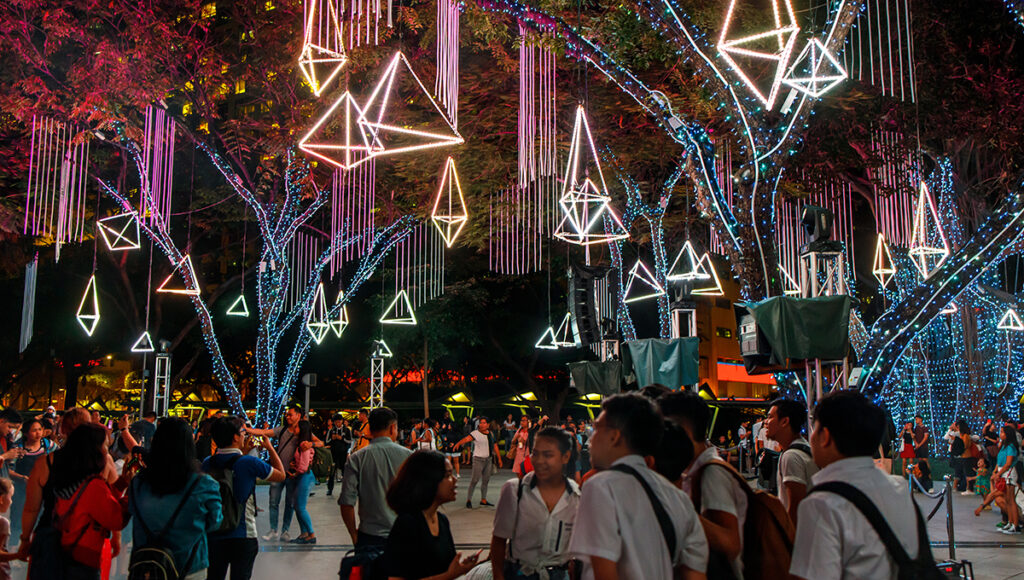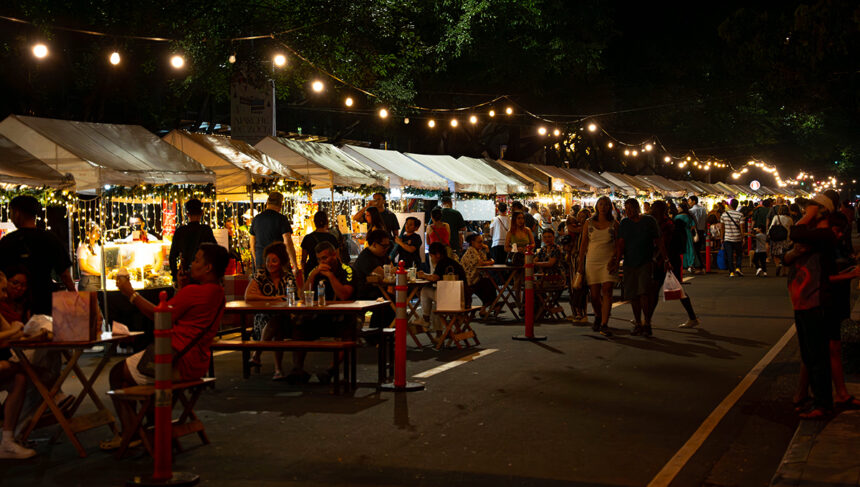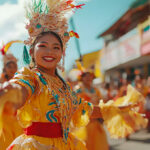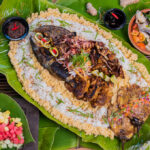Visiting the Philippines in December is a fantastic idea. The dry season begins here, and the weather is generally bright and sunny. Plenty of activities are waiting here, whether your interests are in huge, menacing sky-high volcanoes or immaculate coral reefs. With more than 7,000 islands, this sun-drenched archipelago becomes a paradise for outdoor enthusiasts and beachgoers during this season. Visiting the Philippines in December might be a bit of a challenge due to the high volume of tourists, especially towards the end of the month.
This results in packed sites and more Philippine Holiday Packages, accommodation and tickets.

The December Weather in the Philippines
In the Philippines, December is distinguished by rather mild temperatures. For example, the pleasant average highs of 30°C (86°F) and lows of 23°C (73°F) found on Luzon and Visayas islands. While the Philippines’ dry season runs through December, one cannot eliminate precipitation.
The average monthly rainfall in Luzon is 145 millimetres, whereas in Visayas it is 110 mm. Mindanao’s southern portion and the East Visayan Islands typically get less rainfall. A little rain shower or two is unlikely to ruin your holiday plans unless a tropical storm or typhoon is approaching, which is rare but not unusual. Travelling to the Philippines in December offers a perfect blend of festive spirit and pleasant weather, making it a popular time for tourists.
Why should one visit the Philippines in December?
There are many strong arguments for scheduling a December trip to the Philippines. Here are some of them.
- Perfect climate: Want to kick back on the shore carrying a cocktail? December’s pleasant temperatures mean you won’t have to spend your trip fretting about the weather turning on you. Also a great time to enjoy watersports, including diving, surfing, and kitesurfing in locations like Siargao and Cebu.
- Outdoor adventures:With mild weather and little precipitation, December is an ideal month for island hopping or trekking through picturesque rice terraces.
- Festivities abound: Filipinos celebrate Christmas with flair. Known locally as “Pasko,” the four-month run-up to December 25 consists of Christmas trees, lanterns, carols, and gifts from a fat, merry Filipino Santa Claus.
The nation also rings in the New Year with celebrations, including fireworks in key cities, including Manila. December also hosts the Shariff Kabunsuan Festival, another noteworthy celebration Celebrated in Cotabato city, it honours the introduction of Islam and incorporates boat racing and cultural presentations.
Where To Go And What To Do In December For the Philippines?
Generally speaking, December brings pleasant temperatures wherever in the Philippines.
Sheltered from the remaining traces of the monsoon, Cebu is a top destination for island-hopping excursions and waterfalls (you should not miss Kawasan Falls). December is also great to marvel at Moalboal’s great sardine run or snorkel with whale sharks in Oslob.
Picture-perfect tropical surroundings abound in El Nido and Coron in Palawan. Lowkey coastal communities like San Vicente and Port Barton will provide beach bums with a calmer slice of heaven.
Since the torrential rain has stopped falling on Luzon, December is an excellent month for outdoor exploration. Hardy hikers can scale volcanoes, including Mayon, Taal, and Mt Pinatubo. For less demanding experiences, go on a trail to the Banaue Rice Terraces. The month of December is also ideal for beginning Christmas festivities.
Not far from Manila, Cavite City features a variety of brilliant, dazzling lights and early morning feasts of traditional Filipino Christmas cuisine. The Festival of Lights at the Ayala Triangle brightens the posh district of Makati within the capital. Follow your ears for live Christmas carols and K-pop hit performances.
San Fernando in Pampanga’s vibrantly coloured parol lanterns make it the Philippines’ Christmas capital. During the Giant Lantern Festival (Ligligan Parul), local sub-districts battle their neighbours with these massive festive beacons.
The Baguio Country Club Christmas Village displays a brilliant array of lights and decorations in the cool city of Baguio. Do not miss its snow show and nativity pageant.
Making Plans for a December Trip to the Philippines
In the Philippines, December is when most tourists go. The nation has bright skies and comfortable temperatures as the dry season starts. Guests can engage in various activities from beach holidays to hiking to sightseeing. If you’re planning your trip, explore more about Philippines holidays to make the most of your itinerary. Particularly towards the end of the month, the famous tourist destinations should be packed as the nation gets ready for Christmas and the New Year.
If you are hoping to visit in December, see our Philippines travel guide or contact our travel consultants to arrange a tailored trip to the Philippines.
Spend more time and energy than you might think celebrating Christmas in the Philippines.
Christmas celebrations in the Philippines are already underway by early December and have been for weeks.
Not even the most well-known Christmas destinations in the world—in Europe, Scandinavia, the Baltic States, New York City, or the North Pole, Alaska—can claim the longest and perhaps most bizarre Christmas celebrations the Philippines has.
Although this archipelago of 7,600 islands and 110 million people is Southeast Asia’s most populous Christian nation, its past may also contribute to the supersized yuletide celebration that has evolved into our identity.
The Christmas season in the Philippines lasts much longer than just a few days or weeks. It is, indeed, a season in the most literal sense. In fact, the Philippines in December becomes one of the most festive places in the world, where what may seem to some as excessive is a time that captures the Christmas spirit with helpings of joy, thankfulness, and unique connections. And who would not want to hang onto that emotion just a little longer?
The basis of curiosity
Christmas arrived in the Philippines, apparently in 1324. Two centuries before Spanish colonists arrived, Father Odorico, a Franciscan missionary from Pordenone, Italy, survived a shipwreck and introduced the delight (and expense) of commemorating the birth of the Saviour to our shores. A marker at St. James Parish Church in Bolinao, Pangasinan, Northern Philippines, purports to identify the spot where the first Christian Mass and the first Christmas in the Philippines in December was observed.
The distinctive holiday customs of the Philippines started to take root and grew steadily only when the Spanish conquistadores named the country “Las Islas Filipinas” in 1543. Feast days of saints and special days in the Christian calendar added 19 festivals observed annually in the Philippines as the colonists supplanted early religious practices with Catholic pomp and ceremony.
Our remarkable tropical Baroque churches, dispersed around the islands, nevertheless follow Catholic Christmas customs – including some archaic ones. You can learn more about the country’s vibrant Christmas heritage and practices from this National Commission for Culture and the Arts (NCCA) resource.
Having fun before dawn
Misa de Gallo, also known as Mass of the Rooster or Simbang Gabi, is one of the more well-known. It begins before sunrise nine days before to Christmas. Filipinos think your wish might come true if you go to all nine Masses.
If that doesn’t make you want to get out of bed, the smell of rice cakes cooking in a queue of shops outside the churches will. There are two main types of Filipino rice cakes: bibingka, which is buttery and cooked golden and fluffy and topped with grated coconut, cheese, and salted duck egg slivers, and puto bumbong, purple sticky rice fingers.
Fill them up with tsokolate-eh, thick hot chocolate made in the style of espresso, or tsokolate-ah, lighter hot chocolate, or try a spicy salabat, fresh ginger tea.
For night owls, on the other hand, the midnight Christmas sales that start in October may bring them holiday cheer. Around the country, malls and bazaars are decorating their floors for longer buying hours. People can also find deals on items that would make great Secret Santa or school gift-exchange gifts. If you usually wait until the last minute to shop, the longer hours may help you finish your Christmas shopping.
Watching stars
Parols and star-shaped lights help to ease the standstill traffic and long checkout queues. The Star of Bethlehem, theshepherds, and the three Magi in the stable are the source of these clear markers of Filipino Christmas.
Many elementary schools make the making of these paper stars into craft projects, which can be challenging and messy but, finally, significant means to include Christmas in the classroom.
See the city of San Fernando in Pampanga, some forty miles north of Manila, and let the professionals handle the work for a more polished appearance. The tour is worth it. Here, every hamlet crafts its best parols—made from coloured mother-of-pearl faces and welded steel braces—wired to produce an amazing Christmas light experience for Paskuhan, regarded as the largest Christmas attraction in the Philippines.
Christmas sensations
Filipino Christmas customs also inspire homebound yearning. About 1.7 million Filipinos work overseas; after a year away from family and the familiar, about 180,000 return home for the holidays, where they can satisfy their cravings for Filipino holiday cuisine popular at this time of year: the sweet and savoury embutido, a steamed meatloaf; the caramel-coated leche flan; the festive purple deliciousness of ube halaya, or purple yam jam. Many are included in Catholic Christmas customs.
The delicious, pineapple-glazed Christmas gammon is the mainstay of Noche Buena or the feast on Christmas Eve. Days of preparation with traditional side dishes including pancit, or stir-fried glass noodles; lumpia, a crispy, fried vegetable and pork roll; a macaroni salad (Pinoy, or Filipino, style, with a sprinkling of raisins); and the kid-approved Filipino spaghetti (more sweet than savoury). After the feast, many families begin planning their holiday getaways, often heading to the best beaches in Philippines to enjoy the sun and sea during the festive break.
The heirloom recipes become particularly significant for those who have been away from the dinner table for a year or more. As is the fullness of the family circle, the food is fulfilling.
And as the new year starts…
The Philippine holiday of Black Nazarene Day, which occurs on January 9, marks the end of the Christmas season for many Filipinos. To honour the dark-skinned wooden picture of the Saviour, crafted by an unnamed Mexican artisan in the 16th century, many swarm to the Quiapo church in Manila. Originally brought to the Philippines in December 1606, the image is supposed to have magical healing and prayer-granting powers when touched, so the custom has attracted hundreds of thousands of followers. That’s a deserving conclusion for Filipino Christmas.
Christmas in the Philippines celebrates happiness, optimism, legacy, and homecoming despite its colonial past and commercialised character. Although historical, social, and environmental injustice is not new, Filipinos remain resilient. Is there a greater moment or cause to underline their sincere hospitality and readiness to share the joy in family and the love of community?
Conclusion
Christmas is lovely. Celebrating early Christmas in the Philippines is a wonderful and distinctive experience that embodies the Christmas season. This time of faith, family, and customs has been handed down for many years. The enchantment of this long celebration – complete with glittering Christmas lights and exquisitely adorned Christmas trees – continues to uplift and unite the Filipino people. At World Pinoy Flights, we’re here to help you experience the joy of a Filipino Christmas firsthand, wherever your journey takes you.









